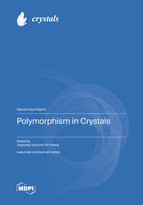Polymorphism in Crystals
A special issue of Crystals (ISSN 2073-4352). This special issue belongs to the section "Crystal Engineering".
Deadline for manuscript submissions: closed (20 February 2023) | Viewed by 25435
Special Issue Editors
Interests: polymorph; pesticide; crystal engineering
Interests: polymorph; crystal engineering; functional crystal material
Special Issues, Collections and Topics in MDPI journals
Special Issue Information
Dear Colleagues,
Polymorphism, the property of a compound to crystallize in more than one distinct crystal form, plays an indispensable role in researching and developing pharmaceuticals, agrochemicals, materials, and food. Polymorphs exhibit different properties, such as crystal habit, solubility, dissolution rate, melting point, stability, mechanical properties, even bioavailability, which may influence product quality. Therefore, the study on polymorphs’ behavior can provide a theoretical basis for selecting optimal solid forms and serve for the polymorphic control and optimization of products as a primary method. Recently, significant progress has been made in the experimental discovery and theoretical prediction of crystal polymorphs. A large quantity of molecules have been discovered to have polymorphs that are mainly attributed to the molecule’s conformational flexibility and the existence of various functionalities in the molecule that could act as hydrogen bond donor/acceptor. In addition to conventional solution crystallization, more polymorphisms have been found in the melt, in confinement, and in the presence of ultrasound/lasers.
Moreover, computational predictions usually yield far more possible polymorphs than are known. The ultimate limitations of experimental reachable polymorphs and thermodynamical and structure–activity relationships of the polymorphs remain an open question. The present Special Issue on “Polymorphism in Crystals” invites status reports summarizing the progress achieved in recent years.
Dr. Jingxiang Yang
Prof. Dr. Xin Huang
Guest Editors
Manuscript Submission Information
Manuscripts should be submitted online at www.mdpi.com by registering and logging in to this website. Once you are registered, click here to go to the submission form. Manuscripts can be submitted until the deadline. All submissions that pass pre-check are peer-reviewed. Accepted papers will be published continuously in the journal (as soon as accepted) and will be listed together on the special issue website. Research articles, review articles as well as short communications are invited. For planned papers, a title and short abstract (about 100 words) can be sent to the Editorial Office for announcement on this website.
Submitted manuscripts should not have been published previously, nor be under consideration for publication elsewhere (except conference proceedings papers). All manuscripts are thoroughly refereed through a single-blind peer-review process. A guide for authors and other relevant information for submission of manuscripts is available on the Instructions for Authors page. Crystals is an international peer-reviewed open access monthly journal published by MDPI.
Please visit the Instructions for Authors page before submitting a manuscript. The Article Processing Charge (APC) for publication in this open access journal is 2600 CHF (Swiss Francs). Submitted papers should be well formatted and use good English. Authors may use MDPI's English editing service prior to publication or during author revisions.







